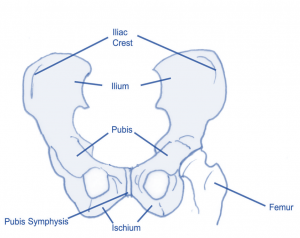The pelvic girdle
The pelvic girdle consists of strong sturdy bones which form a complete bony ring.
The bones which make up the pelvic girdle are the two hip (coxal) bones, which connect to the sacrum of the vertebral column.
Each of the hip bones consists of three bones – the ilium, ischium and pubis – which are fused together.
They articulate with each other at the pubis symphysis in front (a cartilaginous joint) and with the sacrum at the sacroiliac joints behind. This arrangement provides a strong, relatively immobile structure.
This is very important in the transmission of weight between the trunk and the lower limbs and helps to dissipate forces from impact. The pelvis also functions to protect the internal reproductive organs and the bladder.
Where the ilium, ischium and pubis meet is a deep hemispherical socket called the acetabulum on the lateral (side) surface of the pelvis. The acetabulum articulates with the femur forming the hip joint. The acetabulum is much deeper than the glenoid fossa at the shoulder joint, and is better supported by ligaments and muscles – it is therefore far more stable than the shoulder joint, but range of movement (ROM) is far less.
In females, the pelvis is deeper, wider and more rounded, and is tilted slightly forwards. The acetabulum (socket in the pelvis into which the femur fits) in females is tilted slightly backwards. This leads to a greater Q angle (the angle of the femur down to the knees), which can cause problems in hip, knee and ankle joints, for example, in female runners.

